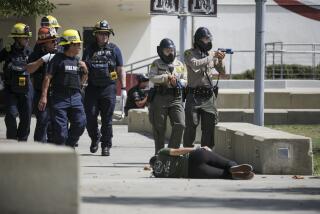Taking the Danger Out of Walking to School
In the three years since Citrus Glen Elementary School opened in east Ventura, Principal Elke Fedde has worried each day whether her students would arrive for classes safely.
Dozens of the 550 students walk to the school tucked off Darling Road or are dropped off on sidewalks lining the heavily traveled neighborhood artery that helps drivers reach Telephone Road.
The sight of speeding drivers, many of whom are parents, and the sound of screeching tires have been common since the kindergarten-through fifth-grade school opened in 1999, and now Fedde must soon prepare for those moments again.
“It was my greatest fear each day until classes started in the morning and again when school let out in the afternoon,” Fedde said.
If Assemblywoman Hannah-Beth Jackson (D-Santa Barbara) has her way, a new measure will be in place by January that she hopes will reduce the number of children being hit by speeding cars.
“We have a lot of pedestrian problems in Santa Barbara and Ventura counties and I want to try and assure our children they will be protected when they are walking to and from school,” Jackson said.
The School Zone Pedestrian Safety Bill, which has been approved by the Assembly and awaits consideration by the Senate Appropriations Committee, would launch a pilot program that could double fines for all traffic violations in school zones in Ventura and Santa Barbara counties.
In practice, that means a driver traveling 35 mph in a 25 mph school zone, for example, would be fined more than $200, according to California Highway Patrol officials. The current fine is about $100.
The additional revenue generated by the higher fine would be placed in a general fund that city and school officials could use to hire more crossing guards and create pedestrian safety programs.
“We don’t control the road and we don’t control the teens driving on the road but we endorsed the bill to try and get some money for education to teach young drivers about safety,” said Kathi Smith, president of the Ojai Unified School District board.
Smith said that pedestrian safety is a major issue in the city and that board members are concerned about speeders in front of Nordhoff High School, which sits beside busy California 33.
“We just had an accident there this past year when one student was driving and two students in the crosswalk were struck,” Smith said. While both victims recovered, Smith said highway drivers continue to speed.
Statistics from the CHP indicate that 93 children between the ages of 5 and 18 were injured, and one was killed, while walking in Ventura County last year.
Oxnard was the third-most dangerous city in the state in 2001 for pedestrians, according to a study released last week of California cities with populations over 100,000. The city reported two pedestrian fatalities and 101 injuries last year.
But Oxnard police officials aren’t certain that Jackson’s bill is the answer to the problem.
“Speed limit signs are the most important thing, but I don’t know that a $200 fine versus a $100 fine is going to slow somebody down,” Police Cmdr. Lee Wilcox said. “I don’t know if it acts as a deterrent.”
Oxnard police officials, like those throughout the county, work with city engineers and school officials to analyze traffic data that help determine where crossing guards are warranted.
At Fedde’s school in Ventura and many other elementary schools across the county there is a paid crossing guard near the busiest intersection. Also at Citrus Glen, parent volunteers monitor other busy intersections.
Not all schools--primarily because of funding, location and traffic levels--are required to have crossing guards.
Wilcox said his department would be open to studying Jackson’s bill and finding new ways to retain crossing guards, perhaps with better pay. Most school districts pay the salaries of crossing guards but look to police agencies to provide training.
Jackson’s bill is essentially a six-year pilot program that would initially involve only Ventura and Santa Barbara counties.
Under the bill, counties, cities or school districts could voluntarily opt to participate in the program, Jackson said.
Officials in both Ventura and Santa Barbara counties support the measure, she added.
Also behind the measure are parent-teacher organizations throughout the state, including the 12th District PTA, which represents all schools throughout Ventura County.
“It’s very interesting,” said MaryAnn Downs of Thousand Oaks, a spokeswoman for the 12th District PTA. “State funding for schools in California is beneath the national average per pupil so something like crossing guards would be considered an extra. Yet we’re talking about the safety of children.”
More to Read
Sign up for Essential California
The most important California stories and recommendations in your inbox every morning.
You may occasionally receive promotional content from the Los Angeles Times.










